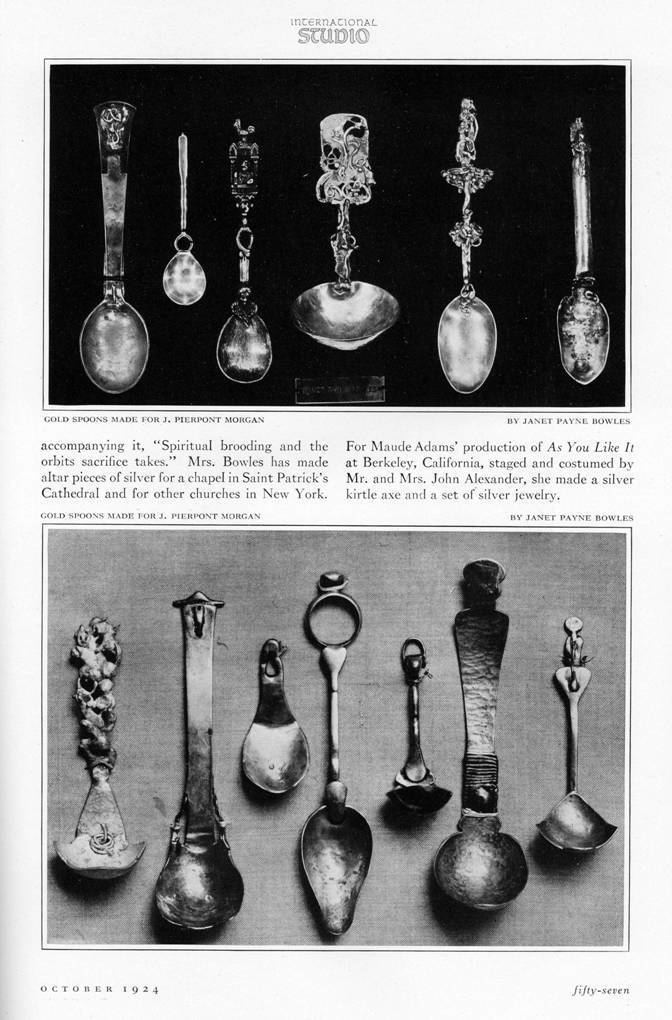Full Name Janet Payne Known for Metalworking Died July 18, 1948 | Name Janet Bowles Spouse(s) Joseph Moore Bowles | |
 | ||
Born 1872 or 1873 | ||
Arts craft jewelry of janet payne bowles
Janet Payne Bowles (c. 1872 – July 18, 1948) was an artist and metal smith from the United States. She is known for creating intricate jewelry, silverware and other small objects. Payne Bowles' work was a favorite of J. P. Morgan, who commissioned numerous works from her.
Contents

Biography
Payne was born in Indianapolis, Indiana, in 1872 or 1873, the daughter of John Godman Payne (c. 1847 – c. 1889) and Mary Byfield (born c. 1846). She played piano for much of her youth, studying under Clarence Forsyth. As a student at Indianapolis High School she studied art under Roda E. Selleck, who was influential in the Arts and Crafts movement in the region. Payne graduated from there in 1890.
Payne then became active in the area's art community. She joined the Portfolio Club, which was an association of area artists, writers, architects, teachers and musicians who gathered regularly for exhibitions, lectures and social events. Payne soon met Joseph Moore Bowles, another Arts and Crafts artist in the area who had helped to found the Portfolio Club and had also begun the quarterly art journal Modern Art in 1893, a publication described as "one of the most influential art journals to spread the Arts and Crafts message." The two were married on October 22, 1895, and moved to Boston. The family had two children, daughter Mira (born in 1902) and son Jan (born in 1904). In the early years they moved often.
Career
After her piano was ruined in a housemoving accident soon after her wedding, Payne Bowles decided music was not her life path. She started writing book reviews for her husband's magazine and providing illumination paintings for published books. When Payne Bowles did not find this fulfilling, she began to attend seminars and to study psychology.
One day while wandering around Boston, she was drawn to the sound of an anvil ringing. Payne Bowles later said, "It was such a beautiful tone that it attracted me irresistibly." She sought out the sound and made the acquaintance of the young Russian metal smith, who agreed to let her help him in his shop. Though he was soon arrested and jailed for a plot to overthrow the United States government, Payne Bowles visited him regularly in prison and continued to learn from him. He even encouraged her to use his now abandoned equipment to set up a metalwork studio in her home.
Along with continuing to write, Payne Bowles began to study metal working more intentionally. She apprenticed with a jeweler, studied stone cutting, and found various artisans to study with.
When the family settled in New York City, Payne Bowles set up a small metal shop making jewelry and other objects. She continued to study metalwork wherever she could find it, visiting the Metropolitan Museum of Art regularly and learning from the metal smiths who cleaned and worked with the collection there. In 1909, she earned a commission to design jewelry for Maude Adams to wear on stage, and her reputation began to grow. Payne Bowles was soon accepting commissions from notable people in the city. Her connections at the Metropolitan Museum led her to work for Sir Caspar Purdon Clarke and J. Pierpont Morgan. Morgan in particular was impressed with Payne Bowles' work, asking her to fashion numerous items of flatware and jewelry from gold that he provided.
In 1912 Payne Bowles left her husband and moved her children back to her hometown of Indianapolis, taking a craftwork teaching position at her high school (now called Shortridge High School), where she continued to teach until she retired in 1942. She then taught alongside her former teacher Selleck as well as Arthur Wesley Dow. As a teacher, she championed a spontaneous, rhythmic approach to art, as opposed to art that is too imitative or structure-based. Her metalworking program at the school was a popular one, and her students regularly won competitions and learned skills not usually studied by students so young.
In the 1920s she entered a gold chalice in an art competition sponsored by Italian art patron J. Bossilini and won first place, leading a to string of commissions from Italian churches.
Though a house fire destroyed a manuscript she had worked on for many years that had been accepted by a publisher, she pieced together a new version from notes and published Gossamer to Steel in 1917.
